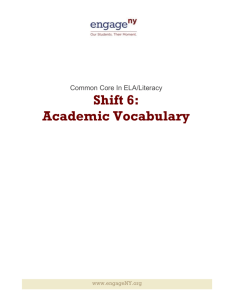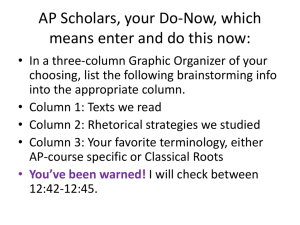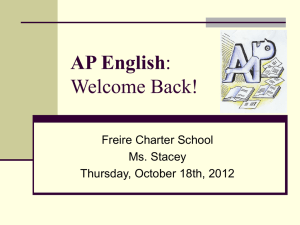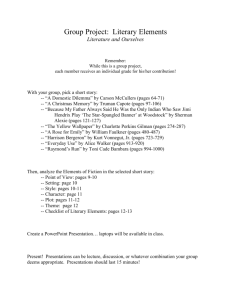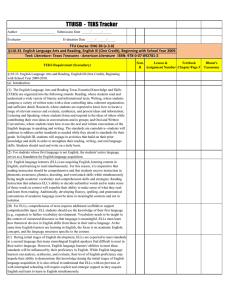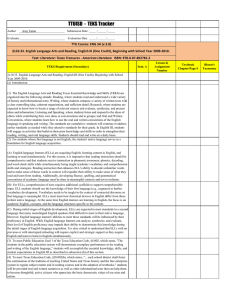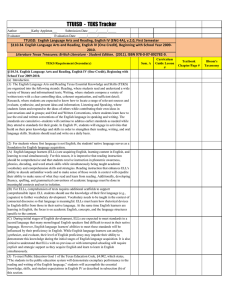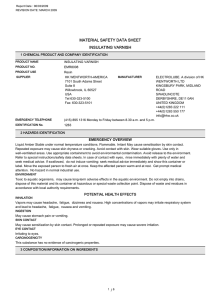Close Reading PowerPoint
advertisement
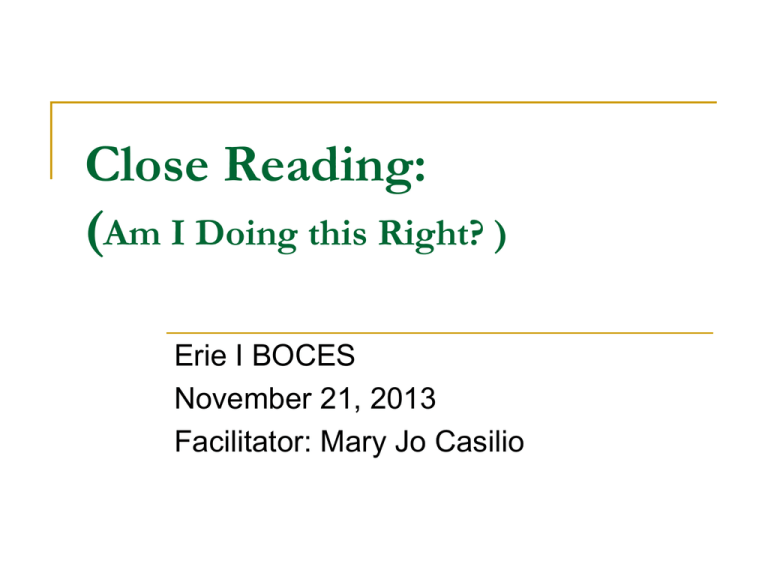
Close Reading: (Am I Doing this Right? ) Erie I BOCES November 21, 2013 Facilitator: Mary Jo Casilio Why are we here? - Yes, the Common Core… Yes, the NYS Assessments… But also…. Reading is just plain good for you! Neurology Study University of Toronto study Stanford – neurobiology & English – study “Be patient toward all that is unresolved in your heart, and learn to love the questions themselves, like locked rooms and like books that are written in a very foreign tongue.” – - Rilke Objectives What is a ‘close read’? What might a close read look like in practice? Elementary / Intermediate MS / HS So… where might we begin? Common Core sets tone… Anchor Standard 1: Read closely to determine what the text says explicitly and to make logical inferences drawn from it; cite specific textual evidence when writing or speaking to support conclusions drawn from the text. Shifts in ELA/Literacy 8 Shift 1 Balancing Informational & Literary Text Students read a true balance of informational and literary texts. Shift 2 Knowledge in the Disciplines Students build knowledge about the world (domains/ content areas) through TEXT rather than the teacher or activities Shift 3 Staircase of Complexity Students read the central, grade appropriate text around which instruction is centered. Teachers are patient, create more time and space and support in the curriculum for close reading. Shift 4 Text-based Answers Students engage in rich and rigorous evidence based conversations about text. Shift 5 Writing from Sources Writing emphasizes use of evidence from sources to inform or make an argument. Shift 6 Academic Vocabulary Students constantly build the transferable vocabulary they need to access grade level complex texts. This can be done effectively by spiraling like content in increasingly complex texts. Anchor Standards & Categories – Reading Reading Writing Speaking/Liste ning Language Key Ideas and Details Text Types and Purposes Comprehension and Collaboration Conventions of Standard English Craft and Structure Production and Distribution of Writing Presentation of Knowledge and Ideas Knowledge of Language Integration of Knowledge and Ideas Research to Build and Present Knowledge Range of Reading Range of Writing & Level of Text Complexity Vocabulary Acquisition and Use Close Reading on Close Reading Read one or more of the Close Reading selections from the packet “Primer” - pgs. 2 & 3 OR “Letting Text Take Center Stage” – pgs. 9-11 Annotate in a way that makes sense for you Complete Qs & Table Share findings with colleague, group Close Reading on Close Reading What are the characteristics of close reading? What is NOT close reading? What misinterpretations or myths about close reading frequently arise? What are text dependent questions? What kind of thinking should they be asking students to do? Anchor Standards & Categories – Reading Reading Writing Speaking/Liste ning Language Key Ideas and Details Text Types and Purposes Comprehension and Collaboration Conventions of Standard English Craft and Structure Production and Distribution of Writing Presentation of Knowledge and Ideas Knowledge of Language Integration of Knowledge and Ideas Research to Build and Present Knowledge Range of Reading Range of Writing & Level of Text Complexity Vocabulary Acquisition and Use Think: The Wizard of Oz Use details and evidence to support your answers! What motivates Dorothy? What role do the red shoes play? What element of the human psyche does the lion represent? What is the climax of the story? How many settings are there in the story? Is it real or is it a dream? What is the theme? EngageNY.org 13 THINK: EVERY LITTLE HURRICANE ~Sherman Alexie Although it was winter, the nearest ocean four hundred miles away, and the Tribal Weatherman asleep because of-boredom, a hurricane dropped from the sky in 1976 and fell so hard on the Spokane Indian Reservation that it knocked Victor from bed and his latest nightmare. Where and when does the story take place? What time of year is it? Why are the tribal weathermen asleep because of boredom? What happens in this first sentence? What do we learn about Victor in this first sentence? EngageNY.org 14 Reading Targets CCSS goal: students leave the lesson having read, analyzed and understood what they have READ. Current goal: Students leave the lesson knowing the details of the narrative and the way a particular “element” is playing out. EngageNY.org 15 Close Reading Complex Text – Guidance International Reading Association Calls for “skillful instructional scaffolding” Rereading Explanation Encouragement Other supports / scaffolding Explicit comprehension strategy instruction Summarizing text as it is read Asking oneself questions about text & answering those questions Recognizing & using text structures to help make sense of & remember text info Visualizing Comprehension Monitoring Other active ways of thinking How are the “experts” talking about close reading? Doug Fisher - Part 1 Doug Fisher - Part 2 “Reading with a Pencil” Annotation/Close Reading protocol Elementary: Close Reading Strategies HS: Article of the Week (DVD) - Stenhouse Publishers Article of the Week Begin with the End in Mind / Sample “New” Regents - Pt. III Q Closely read the text provided… and write a well-developed response of two to three paragraphs. In your response, identify a central idea and analyze how the author’s use of one writing strategy (literary element or literary technique or rhetorical device) advances this central idea. Use strong and thorough evidence from the text to support your analysis. Do not simply summarize the text. You may use the margins to take notes as you read and the next page to plan your response. So, let’s try it… 1st Read: Key Ideas & Details, ie. Read for the Gist or Central Idea Fiction What is the plot? What is the central conflict? Who are the characters? What are there motivations/ Non-Fiction What is the gist or central message? What are the headlines & supporting details? 1st Read – Taking it Further “Rhetorical Situation” – i.e.: Who is the speaker? What is the subject? What is the occasion or context? Who is the audience? What is the purpose? / In other words, what did the author set out to accomplish? Exercise 1 Sherman Alexie – “The Joy of Reading & Writing: Superman & Me” Read #1 – Gist / Central Idea Only Turn & Talk nd 2 Read: What now? nd 2 Read: Craft & Structure aka: Literary Analysis Words Sentences Images Word / Diction Analysis WORD LEVEL QUESTIONS: What word choices (DICTION) does the author make to advance the idea or effect? What types of words draw your attention? Are some words non-literal or figurative? Is the language formal or informal? Slang? Are there certain words with strong connotations? Words with particular emotional punch? Sentence / Syntax Analysis SENTENCE LEVEL QUESTION: How does the author use SYNTAX (sentences) to advance an idea or effect? Are many of the sentences simple? Complex? Does the writer ask questions? How does the writer connect words, phrases or clauses? Does he or she use repetition to make a point? Imagery Analysis Vivid or sensory descriptions? Anecdotes that stay with the reader? nd 2 rd 3 or Read: Craft & Structure – Option 2 Rhetorical Analysis Ethos – Does the author appeal to his or her status, position or accomplishments? Logos – Does the author appeal to logic, numbers, data? Pathos – Does the appeal to emotions? Pull on the reader’s heart? In what way(s)? rd 3 Read: Still more? 3rd Read: Integration of Knowledge & Ideas Why read this text? Where does it fit in the bigger picture? What does the text mean? What was the author’s point? How valid is the text, the point? What would make this text stronger? How does it connect to other texts, ideas? What do I wish to explore further based on reading this text? “Rhetoric is everywhere language is, and language is everywhere people are. To be fascinated by rhetoric is to be fascinated by people, and to understand rhetoric is in large part to understand your fellow human beings. I want to pass on not knowledge, in this book, but love.” – Sam Leith, Words Like Loaded Pistols Additional Resources EngageNY.org www.teachingthecore.org Questions? Feel free to contact me – Mary Jo Casilio mcasilio@e1b.org

